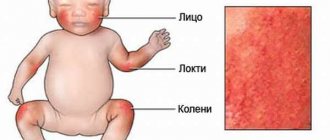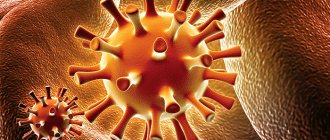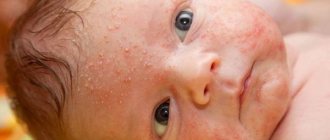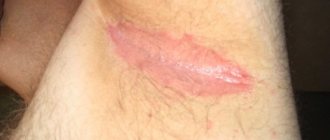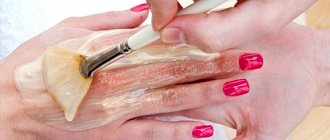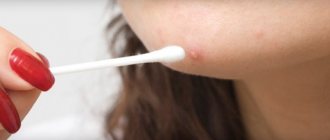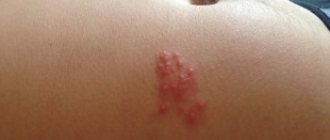Types of rashes
Let's look at the main types of rashes that can appear on the surface of the skin of a baby's tummy:
- Large spots may appear that are connected to form a single formation.
- Small spots that are scattered randomly on the surface of the skin and differ from healthy skin only in color.
- A small rash that appears can cause an increase in the temperature of the skin tissue.
- The formation can take the form of bubbles, inside of which there is a whitish or grayish liquid, while the skin nearby is keratinized.
- In children, the rash on the stomach may vary in color, such as red, white or pinkish.
- The skin itself in the place where the rash is located may change shade, become colorless or, conversely, acquire a pronounced color.
Photos of the main elements of the rash
There are the following types of rashes in a child:
- spot - a non-relief formation on the skin, which differs significantly in color; the spots may be reddened or, conversely, white;
- papule - a nodular rash without cavities that reaches 3 cm;
- plaque - a protruding thickening above the surface;
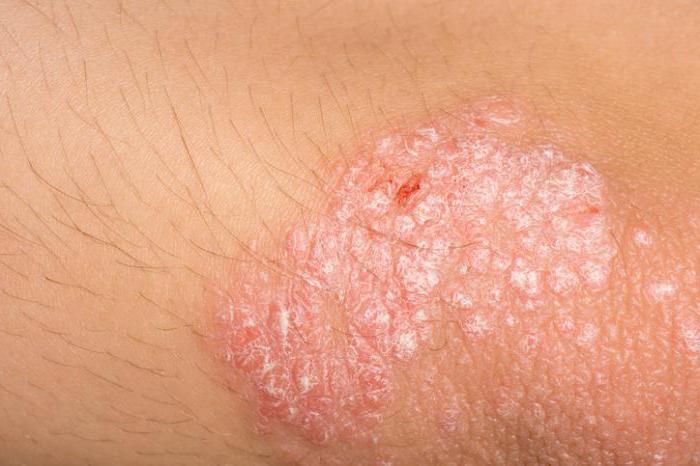
- blisters and vesicles are cavity neoplasms that collect clear liquid;
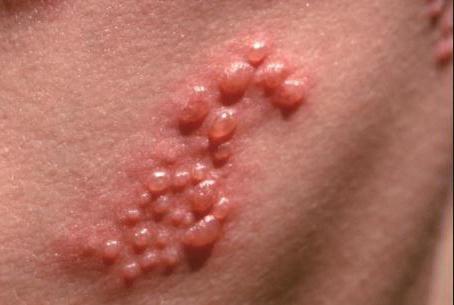
- pustule - a cavity in which purulent contents are present;
- a hemorrhagic rash forms in the form of red dots and spots of varying sizes. If you stretch the skin at the site of the lesion or press on the spot, it will not change its tone.
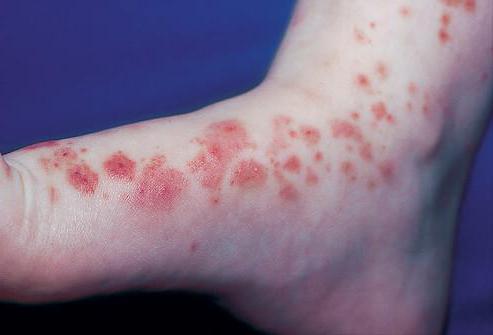
Factors that cause stomach rash in children
Almost every such manifestation is accompanied by itching, which may vary in intensity, depending on the factor of occurrence. If the rash is caused by inflammatory processes occurring in the baby’s body, you should be concerned.
- Dermatitis is a simple skin disease that may not manifest itself in anything other than the formation of a rash.
- An allergic rash on the stomach of a child is the most common factor that causes spots to appear. It can be caused by poor ecology, the child’s interaction with a pet, improper diet, medications and even ordinary ornamental plants can affect the rash. Usually, with allergic reactions, there is also a desire to constantly sleep, watery eyes, and constant sneezing.
- Herpes - with this disease, papules appear on the surface of the abdomen in the form of a belt, which is located at the level of the child’s last rib. This rash on a child’s stomach itches.
- Eczema and psoriasis are diseases of the skin. However, with them, the rash is present not only on the stomach, but also on the baby’s arms.
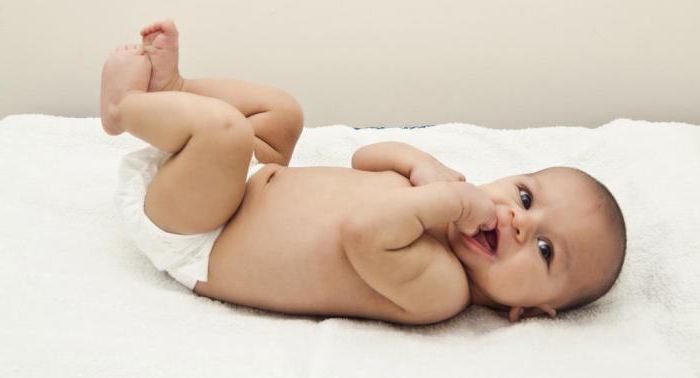
Symptoms of allergic rash in children
You might be interested
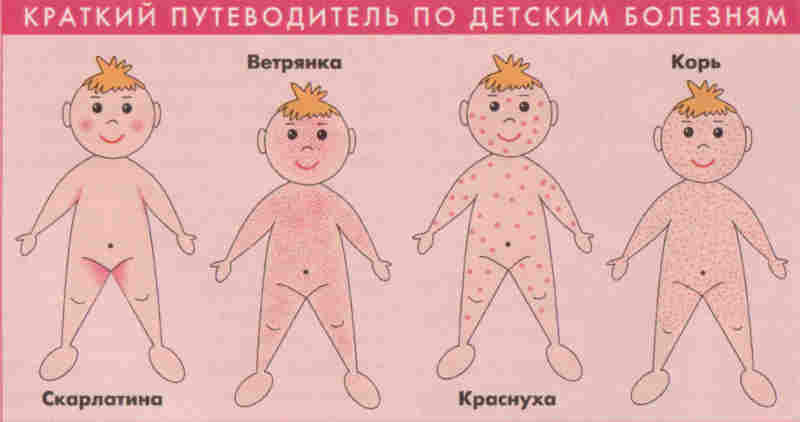
Children's allergies take many forms, but in many cases the body's response to allergens is similar.
At the first suspicion of an allergic reaction, you should be examined by a pediatrician, who, if necessary, will give a referral for tests.
Erythema
Redness in certain areas of the skin is usually temporary and is caused by enlarged capillaries.
Physical erythema is a reaction of the child's skin to adapt to the environment. Usually it goes away within a day after its appearance, if you take appropriate measures: ventilate the child’s skin and use a special baby cream.
Erythema toxicum is an allergic reaction and requires treatment.
Slight swelling at the site of the rash
If your child develops a rash with swelling, this may indicate a food allergy.
Also, swelling at the site of the rash may indicate Quincke's edema and other dangerous diseases.
Small papules - blisters
The presence of papules (nodules) on the skin can be both a sign of allergies and a symptom of measles, exanthema, infectious mononucleosis, psoriasis, urticaria and chickenpox.
Itching, sometimes very severe
An itchy rash in a child is in most cases an allergic reaction, but can also be caused by a skin disease. Itching without a rash is caused by diseases such as eczema and fungus.
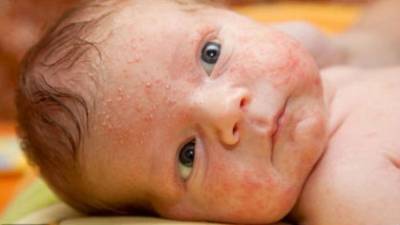
Symptoms of allergic rash in children
What else can cause a rash?
The scabies mite is a small parasite that lives on the human body. It causes not only a rash, but also itching. And he only appears at night. The rash is also present on the skin of the back and between the fingers.
READ ALSO: Rash on the buttocks: types of rashes, causes of appearance, symptoms of the disease, treatment and preventive measures
Failure to comply with personal hygiene rules is very common among children. Due to their age, they do not know how to properly care for their bodies. But the parent may not always immediately pay attention to this. For example, a child may be in water for a long time. Or he may wear the same dirty underwear. Then a rash appears on the child’s stomach without itching.
And, of course, the most common infectious diseases are accompanied by the appearance of various types of rashes. With rubella, chickenpox, scarlet fever and measles, you cannot do without it; it can also be accompanied by itching, or maybe without it. Each disease has its own rash. So with scarlet fever, this manifestation occurs in the groin area in the lower abdomen, accompanied by severe itching. However, after a few days it subsides and turns into normal peeling.
In what cases should you urgently call a doctor?
Be careful and call a doctor immediately if you experience the following symptoms.
- Fever occurs, especially sudden (temperature over 40°C).
- The rash on the child’s body itches unbearably and spreads to the entire body.
- Vomiting and headache appear.
- Confusion of consciousness and speech.
- Hemorrhages with uneven edges, in the form of stars (like varicose veins), without itching.
- Swelling appears and breathing is difficult.
Before the doctor arrives, you should not feed the baby, but plenty of fluids are allowed, and if the temperature rises above 38.5°C, give an antipyretic. It's good if the room is humid and cool. But the child needs to be dressed appropriately, preferably in something spacious, or covered with a soft blanket.
As you can see, skin rashes in children do not always pose a serious danger. But it is important to know the threatening symptoms and immediately seek professional help when they occur in order to avoid complications (and in the case of meningitis, a threat to a child’s life!). Only after a diagnostic examination and samples taken, an experienced doctor will be able to prescribe adequate treatment. If necessary, he will involve other specialists in the research.
You need to call a pediatrician at home so that when going to the clinic the baby’s condition does not worsen (and in case of infection, so as not to infect others). Isolate the child from pregnant women until it is known for sure that the child does not have rubella. And finally, do not refuse vaccination and follow the vaccination schedule. They, along with strengthening the immune system, will protect your child from many problems.
How to figure out what kind of rash a child has? Below you will find photos with explanations of the main skin diseases in children. Have you been caught off guard by baby diaper rashes more than once? Or red dots on the baby’s palms? Now you won’t have any questions about what kind of rash your child has.
Baby acne
Small white pimples typically appear on the cheeks and sometimes on the forehead, chin and even the back of a newborn. May be surrounded by reddish skin. Acne can appear from the first days to 4 weeks of age.
Chickenpox
Chickenpox begins as small, red, itchy bumps. They quickly develop into small, filled pink blisters, which eventually turn into brown, dry crusts. The rash most often begins on the scalp, face and chest, and then spreads throughout the body. As the disease progresses, the rash returns with renewed vigor, usually reaching a number of 250 to 500 blisters, although there are many fewer, especially if the child has been vaccinated. Your child may also have a slight fever. Chickenpox rarely occurs in children under one year of age.
Cold on the lips
Your baby's rash appears as small, fluid-filled blisters on or near the lip. The wound may become larger, break through and dry out. Blisters can appear one at a time or in concentration. Cold sores are rare in children under 2 years of age.
The photo shows a rash on the lips of an adult, but in children the symptoms are identical.
Seborrheic dermatitis
This rash in children is characterized by flaky, dry scalp with yellowish crusts. It can also occur around the ears, eyebrows, armpits and neck folds. Sometimes causes hair loss. This disease is common among newborns and goes away within the first year of a child's life.
Intertrigo
The rash in babies is characterized by reddish, swollen skin in the diaper area. The rash may be flat or lumpy. It causes discomfort when changing a diaper. Most common among children under one year of age.
Fungal diaper dermatitis
Red bumps in the diaper area, it is possible that there are ulcers. Most of all, the rash in children appears in the folds of the skin, as well as with small single rashes outside the concentration of the main rash. It does not go away in a few days and cannot be treated with regular diaper rash cream for babies. Most often occurs in children who have taken antibiotics.
Eczema
The rash in children, characterized by itching, usually occurs on the elbows and knees, as well as on the cheeks, chin, scalp, chest and back. It begins with the appearance of a scaly thickening of the skin with a reddish tint or with the appearance of red rashes, which can be either wet or dry. Eczema is most common in children prone to allergies or asthma. It usually appears at the age of one and goes away by the age of 2, but there are cases when eczema haunts a person into adulthood.
Erythema toxicum
The rash is characterized by small yellow or white bumps on a reddened area of the skin. It can appear anywhere on the child's body. The rash disappears on its own within two weeks and is often found in newborns, usually on the 2nd to 5th day of their life.
Erythema infectiosum (Fifth disease)
In the initial stage, there is fever, aches and cold symptoms, and in the following days bright pink spots appear on the cheeks and a red, itchy rash on the chest and feet.
Most often, this rash occurs in preschoolers and first-graders.
Folliculitis
Pimples or crusty pustules appear around the hair follicles. They are usually located on the neck, armpit or groin area. Rarely found in children under 2 years of age.
Rash on hands, feet and around mouth
Characterized by fever, lack of appetite, sore throat, and painful sores and blisters in the mouth. The rash may appear on the feet, palms of the hands, and sometimes on the buttocks. At first, the rash appears as small, flat, red dots that may develop into bumps or blisters. Happens at any age, but is most common among preschoolers.
Hives
Raised, red patches of skin characterized by itching may appear and disappear on their own. Usually they appear from several hours to several days, but there are cases when they drag on for up to weeks or months. They can appear at any age.
Impetigo
Small red bumps that may itch. They often appear near the nose and mouth, but can spread to other areas of the body. Over time, the bumps become ulcers, which can break out and become covered with a soft yellow-brown crust. As a result, the child may develop a fever and swollen lymph nodes in the neck. Impetigo most often occurs in children aged 2 to 6 years.
Jaundice
The rash in children is characterized by a yellow tint to the skin. In dark-skinned children, jaundice can be identified by the whites of the eyes, palms or feet. It is most common in children in the first and second weeks of life, as well as in premature infants.
Measles
This illness begins with fever, runny nose, red watery eyes and cough. After a few days, small red dots with a white base appear on the inside of the cheeks, and then the rash appears on the face, spreading to the chest and back, arms and legs with feet. At the initial stage, the rash is flat, red, and gradually becomes lumpy and itchy. This continues for about 5 days, and then the rash turns brown, the skin dries out and begins to peel. Most common among children who have not been vaccinated against measles.
mile
Miles are small white or yellow bumps on the nose, chin and cheeks. Often found in newborns. Symptoms go away on their own within a few weeks.
Molluscum contagiosum
The rashes have a hemispherical shape. The color matches normal skin color or is slightly pinker, having a pinkish-orange tint with a pearlescent tip. In the middle of the hemisphere there is a depression somewhat reminiscent of a human navel.
Unusual for children under one year of age.
Papular urticaria
These are small, raised rashes on the skin that become thicker and reddish-brown over time. They occur at the site of old insect bites and are usually accompanied by severe itching. They can appear at any age.
Poison ivy or sumac
Initially, small patches or patches of swollen and itchy red patches appear on the skin. The manifestation occurs after 12–48 hours from the moment of contact with a poisonous plant, but there are cases of a rash appearing within a week after contact. Over time, the rash develops into a blister and crusts over. Sumac is not typical for children under one year old.
Rubella
As a rule, the first symptom is a sharp increase in temperature (39.4), which does not subside for the first 3–5 days. A pink rash then appears on the torso and neck, later spreading to the arms, legs and face. The baby may be fussy, vomit, or have symptoms of diarrhea. Most often occurs between the ages of 6 months and 3 years.
Ringworm
A rash in the form of one or several red rings, the size of a penny with denominations from 10 to 25 kopecks. The rings are usually dry and scaly at the edges and smooth in the center and can grow over time. It can also appear as dandruff or small bald spots on the scalp. Most common in children 2 years of age and older.
Measles rubella
A bright pink rash that appears first on the face and then spreads to the entire body and lasts 2-3 days. Your child may have a fever, swollen lymph nodes behind the ears, a stuffy or runny nose, a headache, and a sore throat. Vaccination reduces the risk of contracting rubella measles.
Scabies
Red rashes that are accompanied by severe itching usually occur between the fingers, around the wrist, in the armpits and under the diaper, around the elbows. May also appear on the kneecap, palms, soles, scalp or face. The rash may cause the appearance of white or red mesh marks, as well as the appearance of small blisters on the skin areas near the rash. The itching is most intense after taking a hot bath or at night, preventing the child from sleeping. Can occur at any age.
Scarlet fever
The rash begins as hundreds of tiny red dots on the armpits, neck, chest and groin and quickly spreads throughout the body. The rash feels like sandpaper and may be itchy. It may also be accompanied by fever and redness of the throat. During the initial stage of infection, the tongue may have a white or yellowish coating, which later turns red. The roughness on the tongue increases and gives the impression of a rash. This condition is commonly called strawberry tongue. Your child's tonsils may become swollen and red. As the rash disappears, peeling of the skin occurs, especially in the groin area and on the arms. Scarlet fever rarely occurs in children under 2 years of age.
Warts
Small, grain-like bumps appear one at a time or in groups, usually on the arms, but can spread to the entire body. Warts are usually a similar shade to your skin tone, but may be slightly lighter or darker, with a black dot in the middle. Small, flat warts can appear all over the body, but in children they most often appear on the face. There are also plantar warts.
Such defects disappear on their own, but this process can take from several months to several years. Warts are not common in children under 2 years of age.
It's no secret that babies' skin is very delicate and often breaks out in rashes or turns red. First of all, this is a signal that the baby’s body is exposed to adverse factors. Parents should read the instructions for a rash on the child's body, photo with explanations
, so as not to be scared at the first manifestations, but to help your child. Parents should have clear ideas about what to do if their child has a rash.
Poor environment and food that does not meet standards are the root cause of most diseases. But sometimes we ourselves provoke a rash on the child’s body.
Such provoking factors may be: the use of medications without prior examination, the use of aggressive household chemicals when cleaning, washing children's clothes and washing dishes. Including a large number of sweets or citrus fruits in the child’s menu, using inappropriate milk formula, and not maintaining hygiene in everyday life and food. Having established the reasons, there is a chance to restore the child’s health.
Allergic rash in children photo
The child’s body’s reaction to allergens is an allergic rash. This is an ominous symptom, indicating that it is necessary to identify allergens and exclude the possibility of their exposure. If measures are not taken, the allergy will develop and turn into severe incurable forms. Risk factors are products containing allergens: chocolate, honey, citrus fruits, rose hips, eggs, infant formula. At the first signs of an allergic rash, it is too early to sound the alarm, but the signal from the child’s body should not go unheeded. Tips for parents
Infants receive allergens from their mother's milk. For example, if a mother eats a lot of oranges, then after feeding the baby, a rash will soon appear on his skin. Pregnant women can give their baby allergies if they don't eat right. There are known cases when, using rosehip decoction in large quantities, a mother provoked an allergy in her baby, who began to suffer a month after birth. Hereditary factors also matter, and if the family suffered from such a terrible disease, then certain forms of allergies will be observed in children.
A child has a rash all over his body without fever
Erythema toxic
may cause a rash without fever.
Irregular red spots cover ninety percent of the body .
A child's rash all over the body without fever goes away after three days as toxins are eliminated from the body. Water on polysorb or other sorbents will help remove toxins.
Occurs in babies up to six months old. If you regularly bathe your child with baby soap, the rash will go away without a trace. The sebaceous glands restore their function, and the skin becomes clean and beautiful. Children need more air baths and cleanliness, less chemicals, good nutrition and care.
Allergic rash
almost never accompanied by fever, but can lead to shock and even suffocation. You shouldn’t be especially alarmed if this is an isolated case, but if the rash recurs, you should identify the allergens and undergo treatment. Allergies can result in asthma or psoriasis. In childhood, it is easier to restore normal functioning of the immune system. If an allergy is left untreated, the consequences can be terrifying. In the chronic stage of allergies, the body destroys itself.
Rash due to enterovirus infection in children photo
If a rash appears on the child’s face or body and is accompanied by nausea, vomiting and diarrhea, then there is every reason to believe that the child has caught an enterovirus infection
.
Abdominal pain also indicates a virus. recognize a rash due to enterovirus infection in children
:
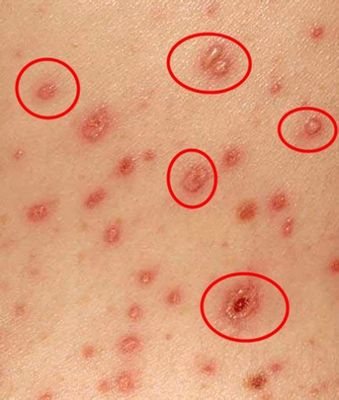
This rash has the configuration of red small nodules, with many nodules localized in the chest and back, arms and legs, and face.
A rash may also appear on the mucous membranes of the mouth and tonsils. In this case, the child experiences pain when swallowing and loss of appetite.
You should consult a doctor immediately, since the rash is very similar to the manifestations of measles and will require examination and collection of tests. Once the diagnosis is made, it is necessary to take the doctor’s prescriptions. As a rule, a viral rash is accompanied by a cough and runny nose, but goes away within five or seven days without a trace.
Rash on a child's back
The rash on the back is accompanied by itching and the baby experiences discomfort and cries. This localization of the rash is typical for prickly heat
when the child is overly wrapped or rarely washed. With heat rash, the rash on the child’s back is pink and very small and itchy.
Pustular acne on the back appears with vesiculopusulosis
. They are filled with liquid and constantly burst, causing suffering and infecting areas of the skin around them. You should not bathe a child with such symptoms. It is necessary to treat bursting blisters with brilliant green so as not to become infected again.
Scarlet fever rash
also localized on the back. If before the appearance of the rash there was a fever and a headache, then these are signs of scarlet fever - an infectious disease. You should quickly consult a doctor for help and get tests done. Treatment will help avoid complications.
Even sunbathing can cause a rash on your baby's back
. The best time to tan is morning and evening, but during the day your baby's skin may become blistered as a result of sunburn. After-sun milk or regular sour cream will help relieve redness.
Rash on a child's stomach
For food allergies
The rash appears first on the abdomen. For example, if a child eats a bucket of strawberries, then within three hours he will be covered in a rash, starting from the stomach and to the top of the head, arms and legs. There will definitely be itching, and the child will be worried.
Rash on a child's stomach
may appear with
psoriasis
, a severe immune disease. But psoriasis is usually preceded by another immune disease - allergies. This rash first appears in the form of small pink papules covered with white scales in the navel area and between the ribs, in the lower abdomen, but if the scales are removed, the papule becomes bloody.
For infectious scabies
Also, the rash breaks out in the abdomen first. At the same time, dark dots are visible on the papule - scabies mites nest there. For scabies, an infectious disease doctor prescribes special medications and ointments and isolates the patient from others.
To prevent a child from getting scabies at home and in kindergarten, it is necessary to change underwear and bed linen more often, and avoid contact with sick people.
The appearance of a rash in various diseases is just a visible part of the damage to human tissue. We don’t see most of it, because the internal organs and blood suffer more.
Red rash on a child's body
A red rash on the body of a child accompanied by fever
occurs with
rubella
, an infectious disease.
You can get infected easily, but rubella
difficult, sometimes with complications. With rubella, the lymph nodes also become enlarged. After taking treatment and restoring health in quarantine, the disease recedes and the skin becomes clear.
A terrible symptom of meningococcal infection
is
a red, star-shaped rash
. These are hemorrhages of blood vessels under the skin. The color may also be purple or bluish. At the first signs of such a rash, parents should take the child to the hospital and preferably immediately to the infectious diseases department. They will do the necessary tests faster there.
Scarlet fever rash
also red. It starts under the arms and then goes down. At the end of the disease, the skin peels off and turns white.
Measles
characterized by a red rash. Not only the child’s body, but also the face can become covered with a solid red spot within a day.
Rash is the child’s body’s reaction to various changes
: the appearance of allergies, the consequences of acute respiratory viral infections and other inflammatory processes, and more. Below the text will describe the causes of the rash on the child’s body, photos with explanations.
When does the measles rash appear?
With measles in children, a rash on the stomach does not appear immediately, but only on the fourth day after the disease begins to develop in the body. It appears first on the head and then goes down to the stomach, while it itches constantly. The rash in this case looks like large pimples merging with each other. When the disease is over, no traces remain. In case of infections, the color scheme of the rash has a reddish tint and a clear structure, which does not allow it to be confused with other causes of skin rashes. In this case, the temperature necessarily rises, weakness appears throughout the body, the child develops apathy towards everything around him, and sometimes clouding of mind occurs. All this disappears as soon as the infectious disease passes.
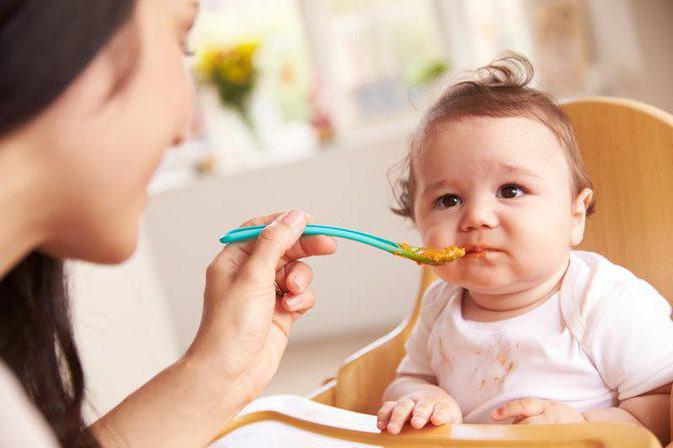
Small red rash
This rash may appear suddenly and within a short period of time. The rash is smooth (does not protrude above the skin level), only its color gives it away. It may also have protrusions, like goose bumps.
To determine the disease, you need to pay attention to the following features:
- rash color;
- area of the rash;
- the nature of the rash (lumpy or smooth);
- is there itching;
- the presence of an increase in temperature (of the whole body or just foci of the rash).
Rashes on the body are typical: with allergies, prickly heat. Maybe it's a trail of nettles. Problems with blood vessels (blood clotting disorders). Or the child has an infectious disease.
Treatment options for a rash on the skin of the abdomen in a child
A minor rash is treated in conjunction with the disease that caused it. With any education, it is necessary to seek medical help from specialists. Of course, if you are sure that it is an allergy, then you can use tablets and special ointments, the action of which is aimed at relieving the allergic reaction. It is also necessary to eliminate the outbreak itself, which provokes these manifestations in the baby.
Skin diseases are also treated with special ointments. In addition, you need to take medications. The most difficult thing is getting rid of scabies; it is a very long process. You need to be very careful with the scabies mite, as it tends to be transmitted to other people. Before starting the course of treatment, the home must be disinfected. Here it is necessary to isolate the patient from absolutely healthy people. All the patient’s belongings are treated with chemicals that can prevent the reappearance of ticks. A rash that forms on the surface of the skin of the abdomen is treated with ointment.
READ ALSO: How to get rid of wen at home using folk remedies
Signs of infant heat rash and remedies for it
Every mother wants to see her child healthy and smiling. But what to do if a rash from prickly heat appears on the child’s body? Heat rash in children is a fairly common disease that most often occurs before the age of one year. First of all, you need to determine the nature of the rash.
Miliaria is irritation and inflammation of the skin, which manifests itself as a result of increased sweating due to overheating. As a result of overheating, the child’s body “tries” to regulate its normal temperature by secreting sweat.
Due to the fact that the sweat glands are not yet perfect and cannot cope with the assigned tasks, sweat accumulates in their mouths, thereby irritating the skin around them.
As a rule, infantile heat rash bothers the child until he is one year old, then it appears extremely rarely.
We diagnose prickly heat by the nature of the rash
The signs of heat rash are quite simple and every mother, knowing what heat rash looks like in children, will be able to recognize it in the early stages of development and prevent its further development. There are several stages of heat rash.
The first stage is crystalline miliaria, which appears on the skin in the form of rare small blisters, up to 2 ml in diameter. There may be a light, clear liquid inside the bubble. These symptoms are not accompanied by itching and do not cause discomfort, both in a child under one year old and in older children.
Most often it appears on the torso, neck, legs, and in places of folds. If you cannot diagnose this disease yourself, then look at the photo;
The second stage is prickly heat. The more severe form, the symptoms of which are accompanied by pronounced itching.
Pimples appear on the body, inside of which so-called nodules can form. Red circles appear around the pimples, which merge with each other to form red spots.
Miliaria appears on the legs of children, on the torso, neck, head, on the bends of the knees and elbows;
The third stage is miliaria alba. What does it look like? The symptoms are quite simple; the blisters fill with a characteristic white liquid. Accompanied by terrible itching. But under no circumstances should you scratch or pierce them, as leaking liquid can provoke other, more serious consequences. Appears: on the stomach, legs, back, butt, neck. Photos will help diagnose;
The fourth stage is prickly heat. The symptoms are the same as with miliaria alba, only now the blisters are filled with yellow liquid. Appears on the legs, shoulders, back, etc. Immediate medical attention is required.
Symptoms of prickly heat in children allow you to diagnose the problem at an early stage and get rid of it in a day (for crystalline prickly heat) or in a week (for red prickly heat). If white or yellow blisters appear in a baby under one year old or in an older child, seek help from a qualified specialist.
Heat rash is a common occurrence in children under one year of age, so every caring mother should know how to quickly and effectively get rid of the existing problem and prevent its more severe forms.
Effective means to combat heat rash
How to treat a rash with fever?
Infectious diseases are always accompanied by an increase in temperature, so treatment is aimed not only at eliminating the cause of these manifestations, but also at lowering the patient’s temperature. Therefore, you need to take antibiotics and antipyretic drugs. These diseases have a negative impact on the immune system; you should also take medications that can increase it.
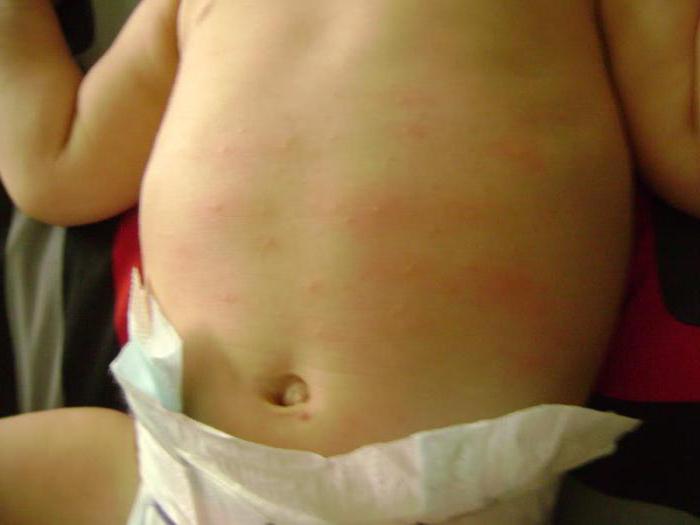
Viral etiology
The following diseases of this group are typical for children:
- As said earlier, one of the most serious diseases is measles. A rash on the tummy appears on the second day of illness, and on the first day it appears on the face. Outwardly, it resembles blisters that are very itchy. As a rule, there is no special treatment, and the course of recovery is aimed at getting rid of intoxication.
- A disease that almost everyone encounters in childhood is rubella. Doctors believe that it is easiest to get over this disease at an early age. The red rash here starts from the head and goes down to the stomach. The lesions themselves can form into small spots. Note that this disease is accompanied by fever, but it is not so high, only about 37.5 degrees. The child's condition is not significantly affected. But for older children, it is very difficult to tolerate the disease, since they have a picture of general malaise, and their body temperature rises to 39 degrees. The most important thing during treatment is to stay in bed and drink plenty of fluids to avoid dehydration. After all, a rash on the stomach and a fever in a child are no joke.
- Hepatitis B virus - here a rash appears all over the child’s body, the stomach is no exception. It is very similar in appearance to hives, small red pimples, but they do not itch. Stays on the body for about three weeks. Treatment is aimed at combating hepatitis.
- Enterovirus infection is a unique disease. In the first days, the patient experiences disorders associated with digestion and a strong increase in temperature, and then on the fifth day a rash begins to appear on the abdomen. It is important that with its appearance the general condition of the little patient is normalized.
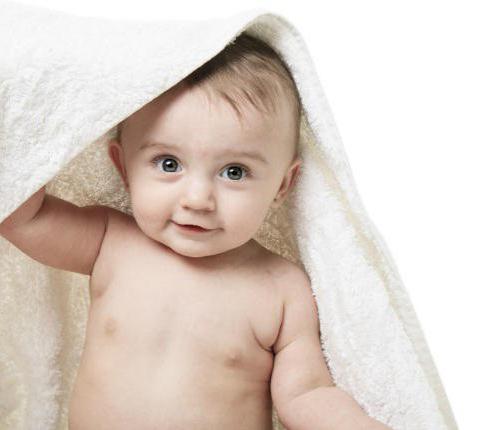
Causes
Only a dermatologist can tell you exactly why the rash appeared. There are many diseases, one of the manifestations of which are acne of various types on different parts of the body. However, they can also appear due to poor personal hygiene or stress.
Allergy
With allergies, the rash most often covers the skin of the arms from the shoulder to the elbow and hand. Allergens can be:
- dust;
- pollen;
- cosmetical tools;
- household chemicals;
- synthetics;
- metals;
- wool and fluff;
- food;
- medications.
There are different types of allergies, each with different symptoms. For example, with contact dermatitis, after interaction with an allergen, a certain area of the skin turns red. Then the area swells and rashes appear that are very itchy.
Drug allergies are mainly caused by certain antibiotics. The rash is spotty and itchy. Often accompanied by an increase in body temperature. Symptoms usually appear in the first two weeks of taking the drugs.
Fungus
Fungal diseases develop in favorable conditions of high humidity and heat. Fungus on the arms or legs is characterized by burning, redness of the skin, and cracks. Symptoms of fungal diseases of the throat are white pimples, ulcers, and redness of the mucous membranes.
In a child who can already walk independently, fungus may appear on the feet due to uncomfortable shoes. Poor quality clothing and contact with an infected person can also be causes.
Vascular and blood diseases
Quite often, the cause of pimples is diseases of the cardiovascular system. They appear due to a reduction in the number of platelets or loss of their functionality, that is, a deterioration in blood clotting. Poor vascular permeability or hemorrhages in the skin may also be the cause.
Symptoms may vary depending on the disease. It is likely that bruises of various sizes and shades will appear, as well as rashes. As a rule, they cover the skin on the fingers, arms, legs, and face.
Hormonal imbalance
Problems with hormonal levels are typical for a teenager. At the age of about 12 years, the level of hormones increases sharply, which leads to the active work of the sebaceous glands. As a result, excess of their secretion is stored in the skin, mixing with dead cells, dust, etc. The pores become clogged, creating favorable conditions for bacteria. Due to their vital activity, inflammation and rashes appear.

Most often, acne is concentrated on the face. If the endocrine system malfunctions, they may appear on the forearm, back, chest, skin of the shoulder or elbow.
Pimples caused by hormonal changes cannot be squeezed out or burned with iodine, brilliant green and other similar means. The infection can spread to healthy skin.
Keratosis follicularis
Follicular keratosis or hyperkeratosis is a disease characterized by skin lesions as a result of inflammation of the hair follicles and an increase in the thickness of the upper layer of the epidermis. Symptoms: papules above the elbow and on the thighs. The disease is caused by metabolic disorders, disruptions in the endocrine system, heredity, and vitamin deficiency.
Treatment is local, using ointments. Vitamins and medications that stabilize metabolism are also used. The disease is prevented by protecting the skin from temperature changes, exposure to sunlight, and using nourishing creams.
Rubella
The disease is caused by a virus that is transmitted by airborne droplets. Rubella is characterized by a gradual onset of symptoms:
- first, red dots appear on the cheeks and forehead;
- After some time, the rash spreads to the shoulders, unevenly distributed throughout the body.
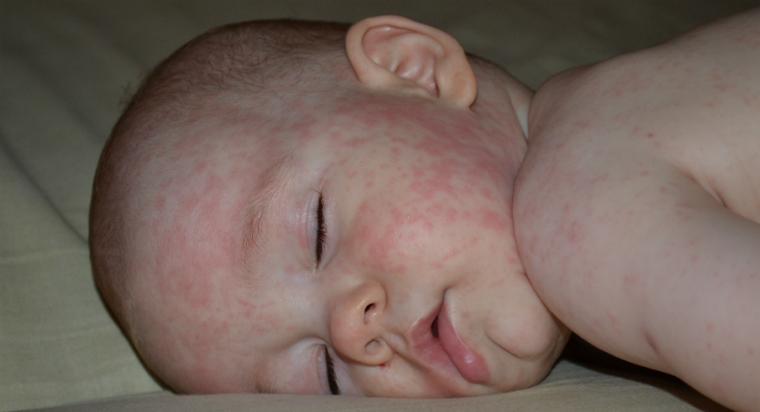
Rubella rash
Rashes often appear in the area of the joints of the limbs and buttocks. The child has a sore throat and red dots appear on the palate. The rash goes away within a few days, leaving no scars or scars. In some cases, it may not appear at all, then the disease must be identified by other signs.
Chickenpox
Chickenpox, commonly referred to as chickenpox, is transmitted by airborne droplets. The incubation period is 14-20 days, after this period of time the child feels weak, the temperature rises and rashes appear.
Blisters are located chaotically on the child’s body, starting from the face and ending with the toes. The only places that remain “clean” are the palms, wrists and feet. The blisters fill with liquid and burst to form a scab. Doctors recommend treating them with brilliant green.
The causative agents of the disease remain in the body along with antibodies. For this reason, under stressful conditions or weakened immunity, it can reappear in the form of shingles.
The disease was widespread previously, but is now quite rare due to universal vaccination. Children are very susceptible to the causative virus, so one person can infect all the other unvaccinated people in the group.
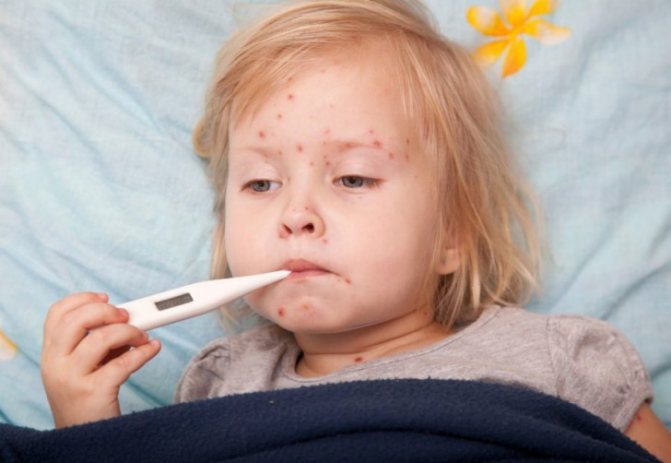
There are 3 stages of the disease:
- incubation lasts 10-12 days, by the end of the first week the child becomes infectious;
- prodromal lasts from three to five days, accompanied by a dry cough, fever, runny nose, redness of the mucous membranes;
- period of rashes - dots appear behind the ears and along the hairline, then the rash spreads to the chest and feet.
READ MORE: How to properly relieve itching, swelling and relief from mosquito bites using traditional medicine
Measles is dangerous due to possible complications - otitis media, pneumonia, encephalitis. Many parents oppose vaccination, arguing that signs of illness appear after vaccination. However, this is the norm; the disease is mild and does not cause harm to health.
Enterovirus infection
Enterovirus infections are a group of infectious diseases caused by viruses of the Enterovirus genus. As a rule, they affect the gastrointestinal tract. They can cause both mild illness and brain damage.
Diseases caused by these viruses are divided into two groups according to severity:
- severe: acute paralysis, hepatitis, meningitis, pericarditis, myocarditis, chronic infections of HIV-infected people;
- moderate: conjunctivitis, fever, pharyngitis, pleurodynia, uveitis, gastroenteritis.
Each disease is characterized by special symptoms, but there are also common ones for all. For example, high temperature, signs of poisoning of the body. The rash appears with fever and pharyngitis, and is usually not accompanied by itching.
Rash due to parasite infestation
In kindergartens, on street playgrounds, at school, a child can easily become infected with scabies. The disease is caused by the scabies mite, which is often called subcutaneous louse. The parasite is transmitted through contact with a carrier or through objects used by an infected person.
Rashes appear in the form of blisters between the fingers, on the stomach and other areas with delicate skin. You may notice a blackhead inside the pimple. The itching intensifies in the evening, becoming unbearable.
Insufficient hygiene
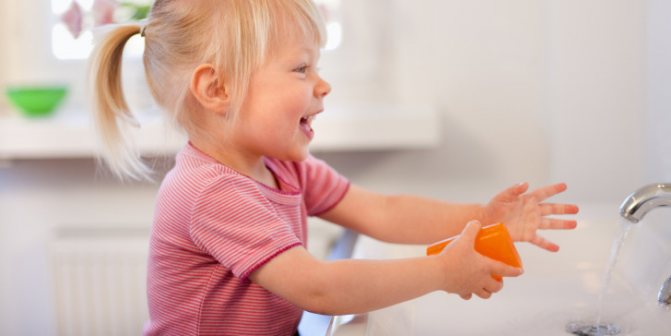
It turned out that a red rash on a child’s body or its individual parts can appear for quite a few reasons:
- postpartum rashes;
- poor hygiene;
- overheat;
- infection:
- allergy;
- eczema;
- lichen.
Acne in children A child's immunity is formed as the body becomes familiar with various infectious diseases. Acne in a child can be a consequence or symptom of these diseases (sometimes very serious), so acne cannot be left unattended, even if it does not cause discomfort in the baby.
Doctors will determine the exact cause of acne in a child based on their appearance, as well as taking into account concomitant diseases and the age of the child.
The main causes of acne in children
Scarlet fever
A streptococcal infection causes a small red rash to appear on a child's body. The disease is accompanied by tonsillitis and general intoxication. Roseola first forms on the cheeks, then the rash spreads to the torso and limbs. The initially bright elements of the rash gradually fade.
Let's look at the main reasons that cause a rash on the face in children.
Non-infectious
Such rashes appear in a child due to imperfect functioning of the endocrine system and periodic increases in hormone levels. This condition is completely temporary and disappears as the child grows.
An immune rash is in most cases accompanied by severe itching. This feature is due to the activation of special immune cells, which release a huge amount of biologically active substances that have an irritating effect on the skin. This condition leads to the fact that the child begins to scratch the damaged skin excessively.
There may be several causes for these rashes:• Allergies• Infection• Parasites
Herpes viruses
This virus has many varieties, let’s consider only those that have one of the symptoms - a red rash on the stomach:
- Chickenpox is an acute disease that is caused by the zoster virus. The rash spreads throughout the body and is very itchy. The general condition of the child is disturbed, there is weakness in the limbs, headaches, and the body temperature rises to 40 degrees. Small rashes merge with each other and form large blisters. For treatment, you can use potassium permanganate and ointment with acyclovir solution.
- One type of herpes is infectious mononucleosis. This disease is characterized by an increase in temperature and the formation of papules on the abdomen, face and chest of the child. It is considered the most dangerous, as it can be the beginning of the formation of Burkitt's lymphoma in the body. The treatment process occurs in a complex of therapeutic measures.
- Shingles - this disease can only occur after the patient has had chickenpox. Occurs against a background of decreased immunity. The rash is located on the body in places where nerve fibers pass. The papules themselves itch and burn very badly. Sometimes it is confused with kidney disease. It is necessary to consult a neurologist and immunologist.
READ ALSO: Mouth ulcers in adults (white sores, sores, ulcers): what are they, reasons why they appeared, treatment, how to get rid of them
What other causes of a rash on a child’s stomach?
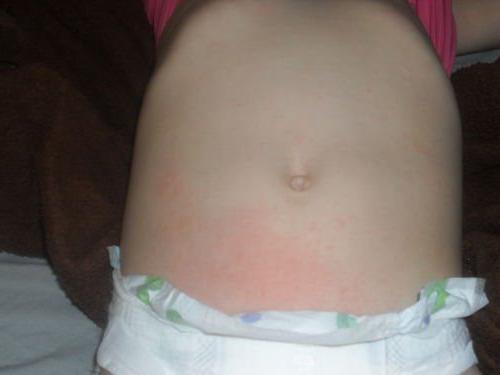
Treatment of eczema
If a rash appears in a child, then antihistamines are given. Cooling gels and antiallergic ointments are used externally.
Dermatologists recommend combining oral administration of an antihistamine with external use of a cream or gel with the same active ingredient. Parents are afraid that such treatment will cause drowsiness in the child and reduce academic performance.
Antihistamines Fenistil, Claritin, Erius, Zyrtec have almost no sedative effect and are better tolerated.
Histamine is released by mast cells in the blood and tissues to help the immune system protect the body from pathogens and toxins. However, in some people, allergies lead to an overprotective reaction directed at harmless substances. Antihistamines block histamine receptors, preventing or reducing itching, swelling, redness of the skin, and lacrimation.
Antihistamines are the most effective for eliminating rashes in acute forms of urticaria. For chronic urticaria, such drugs help only 50% of patients.
Corticosteroid ointments have antiallergic and anti-inflammatory effects. The drugs Fenistil-gel, creams and ointments Elokom, Lokoid, Advantan, Sinaflan, and Flucinar are used externally. Children are given enterosorbents to drink, for example, Enteros-gel or Laktofiltrum. Dietary supplements with lacto- and bifidobacteria are also taken internally.
READ MORE: Vegetative vascular dystonia in adults, clinical recommendations
The translation of the name of the disease from ancient Greek sounds very simple - “skin rash.” Infantile eczema or atopic dermatitis appears before 6 months of age. Dense red spots form on the child’s cheeks without clear boundaries. The disease manifests itself as itching, inflammation and dry skin on the face, wrists, and under the knees
Redness, blisters, crusts, and cracks in the skin are observed in all types of eczema.
The acute phase of the idiopathic form of the disease is manifested by the formation of many blisters. They open, they begin to get wet, after which crusts and stains remain. Typical localizations of true eczema are the face, hands, forearms, feet and knees. Rashes appear symmetrically on the body.
Idiopathic, true eczema is the same as weeping lichen, a chronic itchy dermatosis. A rough rash on the body of a one-year-old child is located on the face, arms and legs, chest and buttocks. There are such stages of the eczematous process as erythema, blisters, erosions, and crusts.
Causes:
- allergies to substances in food, mite secretions, dust, mold, climate change;
- diseases of the digestive system, endocrine system;
- hereditary predisposition;
- stress, psycho-emotional trauma.
As the disease becomes chronic, the skin thickens and peels. Symptoms worsen in climates unsuitable for the child, with excessive dry air. The influence of constant or seasonal action of allergens is noted.
Therapeutic methods and means:
- Antihistamines that relieve itching and inflammation of the skin and mucous membranes.
- Resorcinol solution for cooling and astringent lotions.
- Antiallergic ointments, antiseptic solutions.
- Valerian tincture and other sedatives.
- Enterosorbents to cleanse the body of allergens.
- Oral diuretics to reduce swelling.
- Hormonal ointments (GCS).
- Physiotherapy.
Corticosteroids for external use have anti-inflammatory and antitoxic effects. GCS is included in the ointments "Lokoid", "Dermozolon", "Ftorokort" and "Sikorten". Combined products contain corticosteroids and an antibiotic and are used for microbial eczema. Ointments “Cortomycetin” and “Gioxizon” belong to this group.
If the child is taking any medications at this moment, you should definitely inform the doctor about this and, if it is impossible, stop the medications and choose analogues.
In 80% of cases, these measures are more than enough for the non-infectious rash to first begin to fade, and then completely disappear without a trace.
However, sometimes treatment is unavoidable. An allergic rash may require treatment with antihistamines (Suprastin, Tavegil, Loratadine, Cetrin and others), as well as hormonal ointments (Advantan, Triderm). Such treatment is not always prescribed and not for everyone; the decision on the use of such drugs must be made by a doctor.
Neonatal rash in newborns does not require treatment at all, since it goes away on its own as the level of maternal hormones decreases. Heat rash requires correction of both the microclimate in the apartment and the hygienic principles and approaches that exist in the family.
The child benefits from air baths, bathing without soap with a decoction of string, chamomile, treating weeping diaper rash with baby powder or drying cream (Sudokrem), and treating dry crusts with softening creams with a healing effect, for example, Bepanthen or Dexpanthenol.
If the rash itches, you should avoid scratching, as this increases the risk of a secondary infection. It is necessary to ensure that the child has comfortable clothes and soft bedding so that additional mechanical irritation does not occur.
If the rash intensifies on one cheek on the side on which the baby slept, this may indicate that the child sleeps on linen that has been washed with allergenic substances or mechanically irritates the skin.
By and large, there is no need to treat an infectious rash. It goes away as the child recovers from the underlying disease.
It is only important to prevent scratching, and also to treat with an antiseptic those fragments of the rash that the baby managed to scratch in order to avoid bacterial infection. Aniline dyes – “zelenka” or “Fukortsin”, as well as the drug “Chlorophyllipt” – are suitable for processing.
To achieve results, it usually takes at least 7-10 days of taking these drugs. The first positive effect, as a rule, is noticeable already 2-3 days after the start of using the medicine.
Bacterial agents
Bacterial pathogens often cause neoplasms on the surface of the skin in the abdominal area:
- A disease that affects the skin with staphylococci is called pyoderma. In this case, the patient develops a rash that contains pus. Treatment is prescribed with ointments in combination with antibiotics.
- With scarlet fever, the tonsils become inflamed and a rash appears all over the baby's body, especially on the tummy. A distinctive feature of this disease is a crimson tongue. Your doctor will help you create a treatment plan for scarlet fever.
- Erysipelas is a skin change that can occur anywhere on the body. There is a 20% chance that the rash may be located on the abdomen. In this case, the formations have a rich reddish tint, and their edges may be uneven. There is often an increase in body temperature. Treatment occurs with the use of drugs and ointments.
- Typhoid or typhus are a threat to the life and health of the baby. The symptoms are very distinctive - bloating, constipation, body temperature rises and a rash appears on the stomach. Treatment occurs only in a hospital setting. Today the disease is completely curable.
